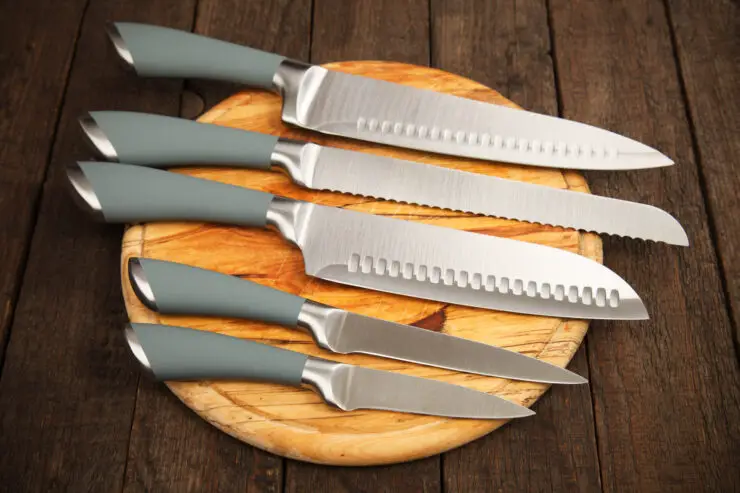As an Amazon Associate I earn from qualifying purchases. Please read the disclaimer for more info.
A good knife can make all the difference in the kitchen, turning tedious tasks into a breeze and elevating your cooking experience. But with so many options available, how do you know which knife fits you? Worry not, as this comprehensive guide will delve into the world of kitchen knives, comparing Japanese and Western knives, exploring essential knife types, and providing expert recommendations for top kitchen knives.
Our recommendation for the best overall kitchen knife is the Shun 8″ Chef’s Knife
From understanding the nuances of blade length to learning the art of proper knife care and maintenance, this blog post will equip you with the knowledge to make an informed decision when choosing your next kitchen companion. So, let’s sharpen our understanding of these culinary tools, specifically kitchen knives, and transform your kitchen experience for the better.
Key Takeaways
- This article examines the features and uses of essential kitchen knives, factors to consider when choosing a knife, proper care and maintenance techniques, as well as expert-recommended knives.
- Japanese vs. Western knives offer different performance options that should be considered based on individual needs.
- Expert recommendations include Shun 8” chef’s knife (best overall), JIKKO Mille Feuille Nakiri Knife (best nakiri) & Victorinox Fibrox Pro Chef’s Knife (budget friendly).
Understanding Kitchen Knives: Japanese vs. Western
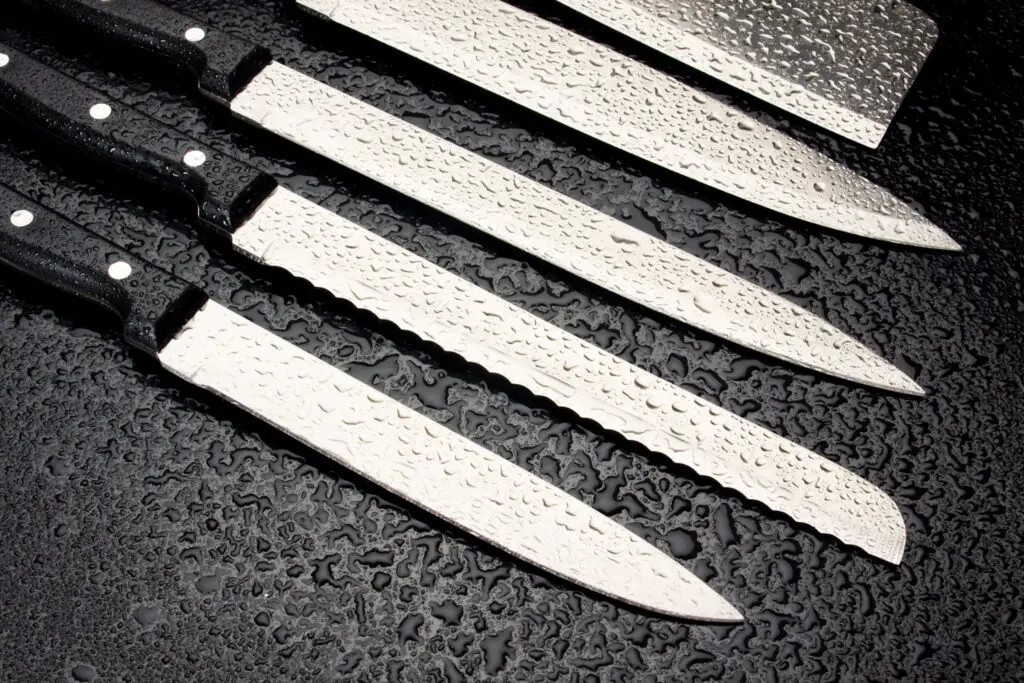
Kitchen knives fall into two main categories – Japanese and Western. Renowned for their harder, sharper blades and precision, Japanese knives contrast Western knives, recognized for their versatility and durability. Each knife type excels in various applications, making it important to grasp their differences when selecting an ideal knife.
Japanese knives typically have the following characteristics:
- Higher rating on the Rockwell Hardness Scale, making them more durable and robust compared to their Western counterparts
- Sharp, aesthetically pleasing, and accurate blades
- Often utilize Damascus steel for added allure
On the other hand, Western knives, also known as Western-style knives, boast a high-carbon, stain-resistant German steel blade, making them perfect for slicing through tomatoes and carrots with a sharp knife. However, they might not be the best choice for delicate tasks such as trimming around bones or using butcher knives for more specialized cuts.
Japanese Knives
Japanese knives, also known as Japanese-style knives, are highly revered for their craftsmanship and performance. With their harder, sharper blades, they excel in delicate and precise tasks, such as slicing sushi or thinly cutting vegetables. Common handle shapes found in Japanese knives include octagonal, D-shaped, and oval-shaped handles, each offering a unique feel and grip.
However, these knives also require more maintenance and care than Western knives. Metal handles may become slippery when cutting fatty meat and are generally easier to maintain than wooden handles.
When it comes to nakiri knives, specifically designed for vegetable preparation, the Tojiro Atelier Nakiri and the Global 7” Vegetable Knife are top choices for their heavier build, striking Damascus-style finish, and super-sharp edge. The Global Santoku knife is another Japanese all-purpose knife that excels in cutting through small chicken bones and separating parts around bones.
Related: Exploring Japanese Knives: Types, Benefits, and More
Western Knives
Western knives, on the other hand, are more versatile and ideal for a variety of tasks. With softer blades and wider edge angles, they cater to a broader range of kitchen applications, such as cutting through crusty bread or preparing a large roast. The Victorinox knife, for instance, features a high-carbon stainless steel blade and is a popular choice for an affordable yet reliable kitchen knife.
Nakiri knives, a type of Japanese-style vegetable knife, share similarities with Western knives in their thin blade, which is straight and designed for precise chopping and slicing. However, their performance may differ due to blade material and construction variations, making the nakiri blade a unique option.
Ultimately, the choice between Japanese and Western knives boils down to personal preference and the specific tasks you’ll be performing most often.
Essential Kitchen Knife Types
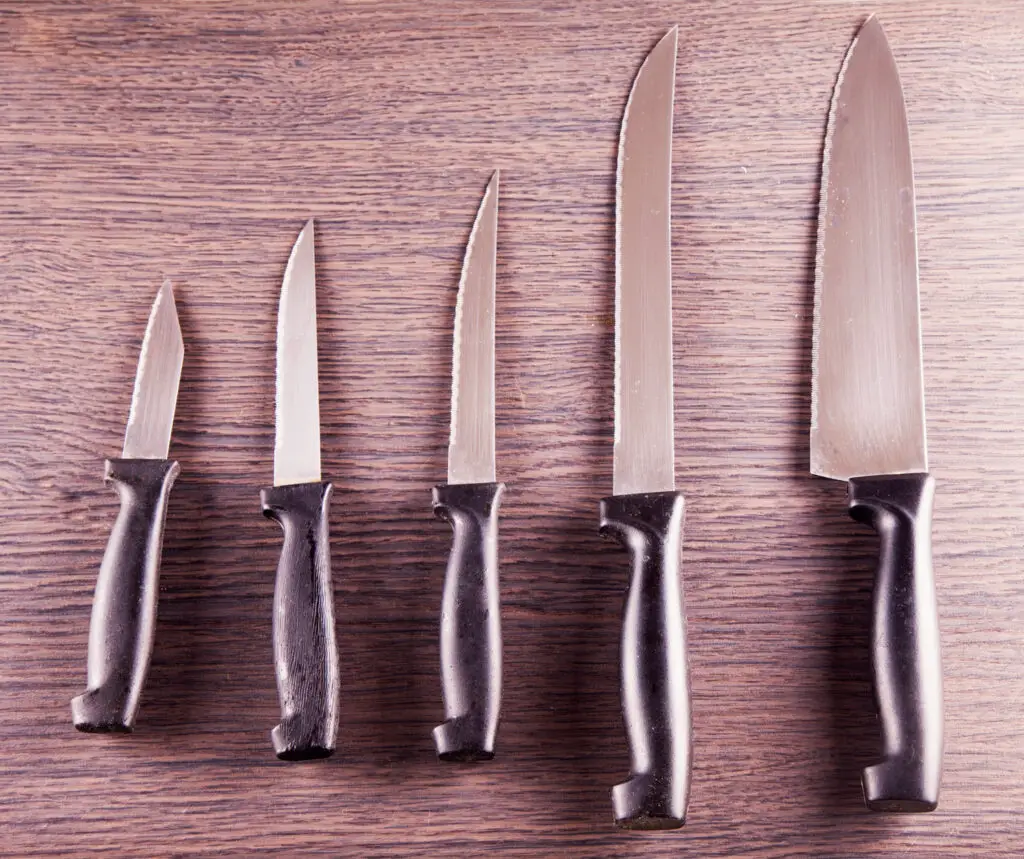
Having explored the differences between Japanese and Western knives, we can now delve into the essential kitchen knife types. Each type of knife has its unique features and uses, making them indispensable tools in the kitchen. Some of the most crucial kitchen knives include:
- Chef’s knives
- Santoku knives
- Nakiri knives
- Bread knives
Comprehending the features and applications of each knife type aids in making an informed decision during your knife selection. Hence, we’ll examine these essential kitchen knives and their unique traits more closely.
Chef’s Knife
A chef’s knife is the quintessential kitchen tool, widely regarded as the most versatile and commonly used kitchen knife. Often ranging between 8-10 inches in length, chef’s knives feature a curved blade that allows for easy chopping, slicing, and mincing. Crafted from superior materials such as stainless steel or carbon steel, these knives require regular maintenance and care to ensure optimal performance.
The chef’s knife is designed to easily handle various kitchen tasks, making it a staple in both professional and home kitchens. Whether you’re preparing a sumptuous feast or whipping up a quick weeknight dinner, the chef’s knife is your go-to tool for:
- Seamless slicing
- Dicing
- Chopping
- Mincing
- Julienne cuts
- Carving
Its versatility and sharpness make it an essential tool for any cook.
Santoku Knife
Another essential kitchen knife is the Santoku knife. This Japanese-style blade typically measures 7-8 inches in length and features a flat edge perfect for chopping, slicing, and dicing. With a comfortable handle crafted from wood or plastic, the Santoku knife offers a secure grip and balance for a wide range of cutting tasks.
The Santoku knife is an excellent all-purpose blade that’s easy to use and maintain. When using a santoku knife, it’s best to employ a slicing or chopping motion rather than a sawing motion, and always use a cutting board to protect the blade and your countertops.
Nakiri Knife
The nakiri knife is a Japanese-style vegetable knife that’s perfect for precise chopping and slicing. Unlike serrated blades, which are ideal for cutting through bread and other soft foods, nakiri knives have a straight edge for clean cuts. Typically ranging between 6-7 inches in length, these knives are designed to make quick work of vegetable preparation tasks.
When selecting a nakiri knife, the blade’s sharpness, the handle’s comfort, and the knife’s weight should all be considered. Proper care and maintenance are necessary to ensure the longevity of the blade, including regular sharpening using a whetstone.
Bread Knife
Bread knives are designed specifically for slicing through crusty bread and other tough foods without crushing them. With a serrated edge and a blade length typically 8-10 inches, bread knives are essential to any kitchen toolkit.
Some bread knives even feature a rounded tip to prevent accidental punctures while cutting. With a bread knife in your arsenal, you’ll be able to enjoy perfectly sliced loaves every time.
Related: The Best Japanese Knife Set of 2024: A Guide to Choosing the Right Set
Factors to Consider When Choosing a Kitchen Knife
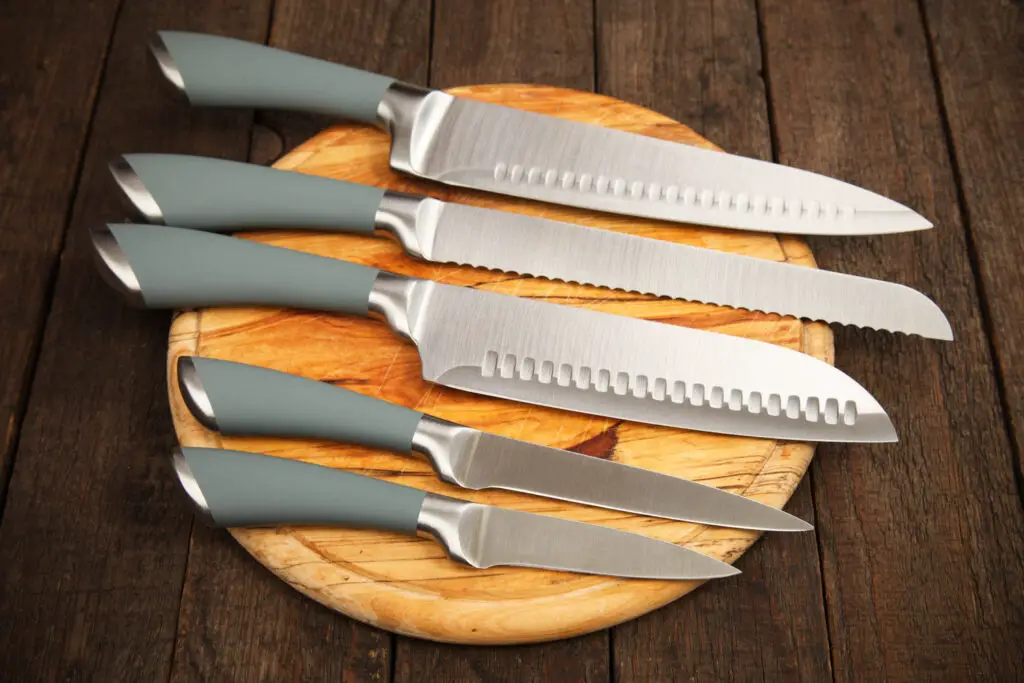
While selecting an appropriate kitchen knife might appear overwhelming, familiarizing oneself with the important considerations can make the process more straightforward. From blade length to handle material and design, there are several aspects to take into account when selecting the perfect knife for your needs. Additionally, balancing price and quality is crucial to ensure you invest in a knife that will serve you well for years to come.
By considering these factors and weighing your personal preferences, you’ll be well-equipped to make an informed decision and select the ideal kitchen knife to suit your needs and enhance your culinary experience.
Blade Length
Blade length is a critical factor when selecting a kitchen knife, as it affects the size of food that can be chopped and the weight and balance of the knife. Longer blades are more suitable for larger food items, while shorter blades are more appropriate for smaller tasks.
Ultimately, the choice of blade length will depend on your personal preferences and the specific tasks you’ll be performing most often.
Handle Material and Design
A kitchen knife’s handle material and design play a significant role in providing comfort and balance during use. From wood to metal and various shapes, there are plenty of options to choose from.
A full tang, where the blade extends through the handle, is often preferred for its durability and balance. Ultimately, the best handle material and design will depend on your preferences and the tasks you’ll most often perform.
Price and Quality
When selecting a kitchen knife, it’s essential to strike a balance between price and quality. Higher-priced knives often offer better materials and craftsmanship, resulting in long-lasting performance and durability. However, budget-friendly options can still provide reliable performance if you’re willing to invest time in proper care and maintenance.
Finding a knife within your budget that still offers the required quality will ensure a wise investment in your kitchen toolkit.
Proper Knife Care and Maintenance
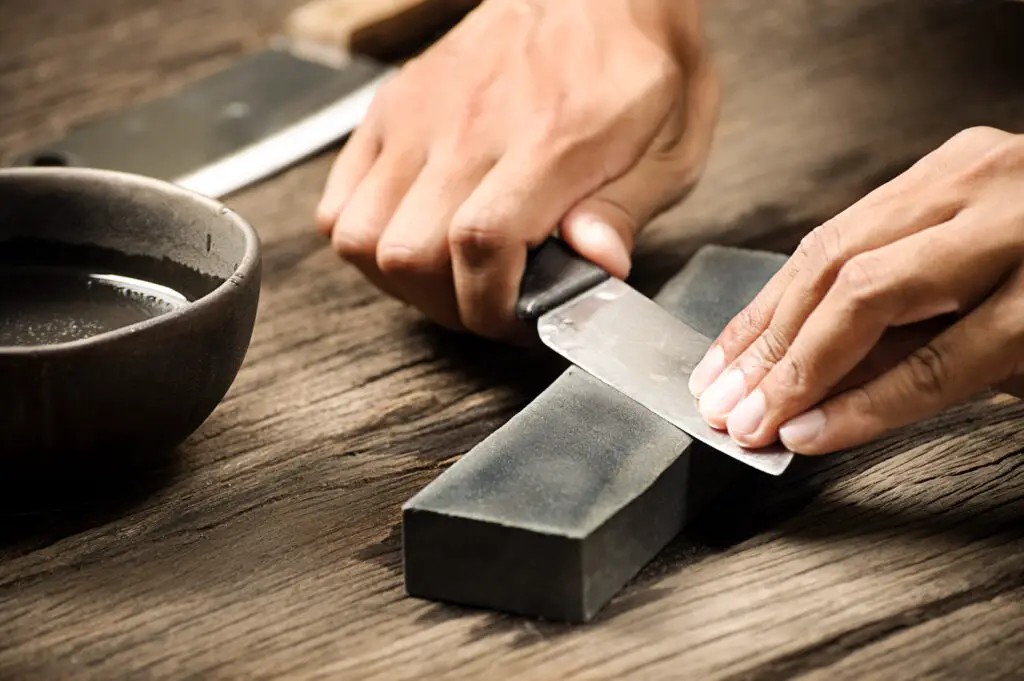
Appropriate knife care and maintenance is key to maintaining your kitchen knives’ sharpness, safety, and effectiveness. This includes understanding the appropriate sharpening techniques, cleaning and storage methods, and avoiding common mistakes that can damage your knives.
Investing time and effort in maintaining your knives extends their longevity and enhances your cooking experience by making it more efficient and enjoyable.
Sharpening Techniques
Sharpening techniques vary depending on the knife and blade material type, with whetstones being a popular choice for maintaining a sharp edge. For high-carbon knives, hand-washing and drying them immediately after each use is essential to prevent rusting or staining.
Whether you’re using a sharpening stone, a honing rod, or a knife sharpener, it’s crucial to follow the manufacturer’s instructions and take necessary safety precautions to ensure the longevity and performance of your knives.
Cleaning and Storage
To clean your knives, use a damp cloth and mild detergent, avoiding abrasive cleaners or scrub brushes that can damage the blade. Dry your knives thoroughly after washing to prevent rusting.
Store your knives in a knife block, in-drawer knife tray, or on a magnetic knife strip to protect the blades and prevent accidents. Proper cleaning and storage will ensure your knives remain sharp and in good condition for years to come.
Avoiding Common Mistakes
Avoiding common mistakes, such as using knives on hard surfaces or for inappropriate tasks, can help prolong the life of your knives. Always use a cutting board to protect your knife blade and countertops.
Refrain from using your knife to open cans, pry open containers, or cut through frozen food, as these tasks can damage the blade. By being mindful of these common errors, you’ll protect your investment and ensure your knives remain in top condition.
Expert-Recommended Kitchen Knives for 2024
Equipped with insights on diverse kitchen knife types, crucial considerations, and appropriate care and maintenance, we can now delve into the expert-recommended kitchen knives for 2024. Our top picks include:
- The best overall chef’s knife
- The best Japanese knife
- The best budget-friendly knife
- The best nakiri knife
These expert recommendations have been thoroughly tested and evaluated, ensuring you make the right choice for your kitchen needs.
From the precision and sharpness of Japanese knives to the versatility and durability of Western knives, our top picks showcase the best of the best in kitchen knife craftsmanship and performance. So, let’s get slicing and dicing with the expert-recommended kitchen knives for 2024.
Best Overall Chef’s Knife
Experts highly recommend the 8-inch pick from Shun as the best overall chef’s knife. This top-rated knife offers a balance of performance, durability, and comfort for a wide range of tasks, making it a must-have in any kitchen.
Crafted from high-quality materials, the Shun 8-inch knife boasts a comfortable grip, a light yet sturdy blade, and a razor-sharp edge that can slice through a variety of items, from vegetables to meat.
Best Japanese Knife
Shun’s 8-inch pick is widely acknowledged to be the best Japanese knife. Experts around the world have praised its quality and sharpness. Showcasing the precision and sharpness that Japanese knives are known for, this knife features a lightweight yet robust blade that can easily slice through various foods, from vegetables to meat.
With a secure grip and an ideal weight, the Shun 8-inch Japanese knife is a testament to the quality materials and craftsmanship of Japanese knife making.
Best Budget-Friendly Knife
For those looking for reliable performance and durability at an affordable price point, the Victorinox Fibrox Pro Chef’s Knife is the expert-recommended best budget-friendly knife.
This cost-effective option provides excellent value without compromising on performance, making it an ideal addition to any kitchen toolkit.
Best Nakiri Knife
The JIKKO Mille-Feuille Nakiri Knife has been rated the highest among nakiri knives for its exceptional performance in vegetable preparation. With a thin, straight blade, this top-rated nakiri knife excels in precise chopping and slicing, ensuring your vegetables are cut to perfection every time.
Summary
In conclusion, understanding the differences between Japanese and Western knives and the essential kitchen knife types is crucial to selecting the perfect knife for your culinary needs. By considering factors such as blade length, handle material and design, and price and quality, you can make an informed decision and invest in the right kitchen knife.
With expert-recommended kitchen knives for 2024 at your fingertips, you’re now equipped to transform your cooking experience and elevate your kitchen skills. So, go ahead, choose the perfect knife, and let the culinary magic unfold.
If you found this article on Japanese knives useful, you might like one of these:
- Finding the Perfect Japanese Pocket Knife for Every Occasion
- The Art of the Japanese Sword
- Best Japanese Chopsticks for the Table
Frequently Asked Questions
The chef’s knife is the most versatile and widely used kitchen knife as its long, sharp blade allows for a range of cutting tasks such as chopping vegetables, slicing steak, mincing herbs, and more. Additionally, a utility knife and Paring Knife can be helpful for smaller food prep tasks. Ultimately, deciding which knife feels best in your hands is the most important factor.
Professional chefs typically prefer chef’s knives, usually between 8 and 10 inches long and made of high-carbon stainless steel. Popular chef’s knives include the Mac Professional 8 Inch Hollow Edge Chef Knife, Global G-2, Masamoto VG-10, Wusthof Classic Chef’s Knife, Made In 8 Inch Chef Knife, Misen Chef’s Knife, Victorinox Fibrox 8-Inch Chef’s Knife, Hedley & Bennett Chef’s Knife, and Shun Classic Chef Knife.
The three most commonly used knives in a chef’s kitchen are a chef’s knife, a serrated knife, and a paring knife. These knives are essential for everyday cooking and can be used to perform various tasks such as peeling and de-veining. Each of these knives has its own unique purpose and should be used accordingly.
Japanese knives boast sharper blades with more precision, while Western knives are more versatile and feature softer blades with wider edge angles. These two types of knives have different advantages and disadvantages, depending on the task at hand.
It is recommended to sharpen your kitchen knives every six months, depending on the type of knife and how often you use it. Use the onion test as a guide.

